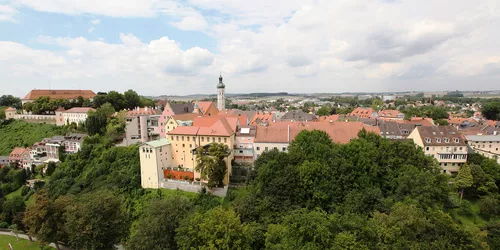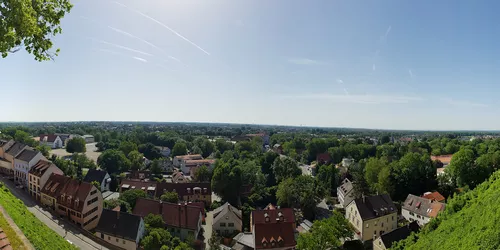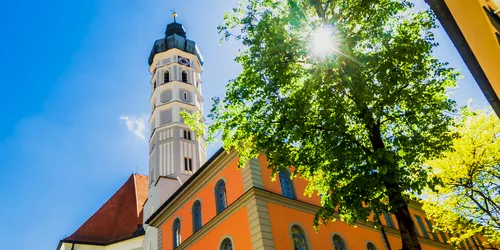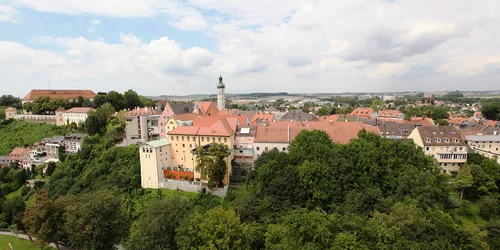
Dachau sights - Upper Bavarian artists' town and place of remembrance
Dachau impresses with its unique art history and numerous interesting excursion destinations. In addition, the Upper Bavarian town has set itself the goal as a place of learning and remembrance to counteract the forgetting of the atrocities committed during the Nazi regime.
How many sights in Dachau do you know? Certainly the concentration camp memorial as a central place of learning and remembrance. But also Dachau Castle, former summer residence of the Wittelsbach dynasty, or the artists' colony Dachau at the end of the 19th, beginning of the 20th century? The picturesque old town with its cobbled streets? Or the insider tip among the excursion destinations: the panoramic view from the Schlossberg over the nearby state capital to the Alps?
The best way to discover Dachau's diversity is to take the Dachau Artists' Trail, a circular route with 18 stops.
The Dachau Artists' Colony
Dachau owes its development into one of the most important European artist colonies of open-air painting in the late 19th century to the special light conditions in the Dachauer Moos. In addition to many well-known painters of open-air painting - such as Adolf Hölzel, Ludwig Dill and Arthur Langhammer - Carl Spitzweg, the landscape painter Christian Morgenstern and the Expressionist Franz Marc also came here. Many works from the time of the artists' colony can be seen in the permanent exhibition of the Dachau Picture Gallery.
Over a distance of approx. 5.7 km, the artists' path leads partly through the city, over Dachau Castle, the courtyard garden, as well as along the Amper River, thus offering a view of Dachau's numerous sights. Along the way, visitors take in the painter's view of his or her subject at each of 18 painting stelae. The starting and end points of the artists' path are both in the old town.
Town Hall with Taschner Fountain
The town hall has stood on its present site for over five hundred years. The Old Town Hall, designed by the Munich architect Georg Buchner with a Baroque gable based on the previous building, was built between 1934 and 1936. Dachau's rapid growth after the Second World War necessitated the construction of a new, larger town hall. This was built in the 1970s as a link between the Old Town Hall and the neighbouring "Lebzelterhaus". In the passageway to the viewing terraces behind the town hall, two memorial plaques commemorate the Jewish citizens of the city who fell victim to the Holocaust.
In the centre of the square in front of the Old Town Hall is the Town Hall Fountain, also known as the "Taschner Fountain", designed by Ignatius Taschner in 1915. The column in the centre of the fountain is decorated with figures of peasants and peasant women in Dachau costume.
The artists' path starts on the town hall terrace. To the second station, the path leads through the historic old town up to Dachau Castle.
Old town ensemble with magnificent town houses
Dachau's old town derives its special charm from the ensemble of magnificent town houses. The so-called "Raufferhaus", where Ludwig Thoma also lived for a time, or two building complexes below the town hall, where two Dachau breweries were located for centuries, are fine examples. The history of the "Hörhammerbräu", for example, goes back to the 16th century. The beautifully structured façade with risalites and plaster rustication from the 18th/19th century is still preserved today. Behind it, for a long time the "Max Joseph Room" was a reminder of the first pompous name-day celebration of the Bavarian king in 1806. At the beginning of the 20th century, artists living in Dachau came and went here. Between the "Hörhammerbräu" and the town hall is the building of the "Zieglerbräu", a brewery also dating back to the 16th century. The inn was frequented by Ignatius Taschner and Ludwig Thoma, among many other artists.
St. Jakob Parish Church
The parish church of St. Jakob, built by the Munich court architect Hans Krumpper, towers over Dachau's old town with its 44-metre-high octagonal tower. In its present form, it dates back to 1624, when the old Gothic church - except for the bell tower and sacristy - was demolished and rebuilt in the late Renaissance style. In 1678, the Gothic church tower was raised in Baroque style with an onion dome and lantern. In the 1920s, the church was again extended to the west. On the south side of the Dachau landmark, the most striking feature today is a sundial dating from 1699, which goes back to the then Dachau mayor and painter Johann Georg Hörmann and, in addition to the time, also shows the month and the twelve signs of the zodiac.
Dachau Palace with Court Garden
Dachau Palace has its origins in a castle built around 1100 and served as the preferred country residence of the Munich court in its heyday in the 17th century. The former four-wing Renaissance palace was built by Duke Wilhelm IV and his son Duke Albrecht V and remodelled in the Baroque style at the beginning of the 18th century on the instructions of Elector Max Emanuel.
Today, only the west wing and the former ballroom section of the palace remain. Cultural events take place in the ballroom, including the renowned Dachau Castle Concerts. Particularly worth seeing is the Renaissance wooden coffered ceiling in the palace hall, considered one of the most beautiful north of the Alps.
In the courtyard garden, in addition to the unique distant view over the state capital Munich, an arcade of 200-year-old lime trees is enchanting. Next to it are countless apple trees. Old apple varieties are cultivated here, as well as pears, plums and apricots. At the time of ripening in autumn, unsprayed apples and pears can be purchased here while stocks last. Adjacent to the courtyard garden is a small wood, the so-called English Garden, which forms the transition to the Amper and Amperauen recreational area.
There, on Fürstenweg, at the steps leading down to the Amper, the third painting stele points the way.
Along the Amper: At the foot of the stairs, you first come out at the Mühlkanal. To the right, the path leads past the hydroelectric power station to the leisurely flowing Amper. The wide river with its low flow velocity is very popular with water birds. Here you will find swans, coots, tufted ducks and little grebes, among others. With a bit of luck, some sun-seeking turtles can also be seen here. They like to find a spot on the deadwood that has become entangled in the banks of the Amper. Beaver gnaw marks can also be seen there.
The artists' path now follows the course of the Amper for a while, reaching both banks via bridges. Afterwards, the stelae locations lead through the Moorbadpark with the water treading facility, across the lower market to the Thomawiese. This is where the traditional Dachau Folk Festival takes place every year in mid-August. Along Ludwig-Thoma-Straße parallel to the Mühlkanal, the path leads back up to the old town via the Martin Huber Steps.
The exact route is described in the flyer on the artists' path. It is available for download or can be obtained at the tourist information office. If you are now curious and would like to learn more about Dachau and its sights, we recommend the 1 1/2 hour free audio tour of Dachau's old town with your own mobile phone.
The city bus line 719 runs every 10 minutes from the station forecourt to Dachau's old town, which is only a few minutes away. The bus gets off at the Rathaus stop.
A visit to the Dachau concentration camp memorial site
Remembering the suffering of tens of thousands of people and promoting an active confrontation of all generations with the crimes of the Nazi regime: this is what Dachau, the site of one of the first concentration camps of the Third Reich, has made its mission. More than 200,000 prisoners suffered terror and abuse here between 1933 and 1945, at least 41,500 lost their lives.
In 1965, the Dachau Concentration Camp Memorial was opened on the site of the former concentration camp. Located on the outskirts of Dachau, it is open to visitors all year round as a memorial and place of remembrance.
Exhibitions document the suffering of the prisoners
The main exhibition focuses on the biographies and individual fates of the prisoners. Reports and drawings by the prisoners make the inconceivable vivid. In six exhibition sections and 13 rooms, visitors can follow the path of suffering of the prisoners. The camp prison and "Barrack X", the second crematorium building erected in 1943 - two original historical rooms - can be visited on site. In addition, two barracks have been faithfully reconstructed. They document the cruel conditions under which the inmates had to live.
The concentration camp memorial can be reached from Dachau station by bus no. 726 in the direction of "Saubachsiedlung" in just under ten minutes.
Konrad-Adenauer-Str. 2-6
85221
Dachau Bahnhof
Our tip: Please make sure to check your train connection and the expected capacity before you start your journey.



